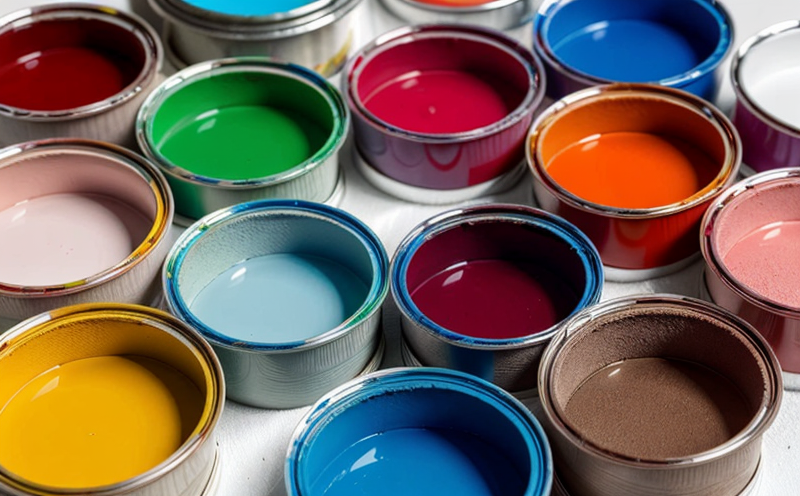ISO 8124-3 Soluble Metals in Colored Coatings
The ISO 8124 series of standards covers mechanical strength and durability tests for toys, including specific requirements related to materials used. The third part, ISO 8124-3, focuses on the evaluation of certain chemical properties of toy parts made from plastics or other similar materials. This includes testing for soluble metals in colored coatings. Such testing ensures that toys meet safety standards by preventing the release of harmful substances into the environment and ensuring they are safe for children to play with.
The significance of this test lies in its role in safeguarding public health, particularly concerning young children who may put objects in their mouths. The presence of soluble metals can lead to ingestion or inhalation, posing risks such as toxicity, allergic reactions, or other adverse effects on human health. By conducting this test, manufacturers and regulatory bodies ensure that toys comply with international safety standards.
The testing procedure involves several steps, including the preparation of samples by cutting them into small pieces (typically 1 cm³) and then immersing these pieces in a specific solution to simulate real-world conditions. After soaking, the sample is filtered, and the resulting liquid is analyzed for the presence of soluble metals. This process allows for the quantification of potentially harmful elements like lead, cadmium, chromium, etc., ensuring that they do not exceed acceptable limits.
The test results are crucial in several ways:
- Regulatory Compliance: Ensures compliance with international regulations such as REACH and CPSIA.
- Risk Management: Identifies potential risks early, allowing for corrective actions to be taken before product release.
- Consumer Confidence: Builds trust in the safety of products on the market.
| Standard | Description |
|---|---|
| ISO 8124-3:2019 | This part of ISO 8124 specifies the test method for determining soluble metals in colored coatings of toy parts. |
| CPSIA Section 105(a)(6) | United States Consumer Product Safety Improvement Act requirement for testing materials used in toys to ensure they do not contain excessive amounts of certain metals. |
The test protocol is meticulously designed to replicate the conditions under which a toy might be exposed to environmental factors. This includes variations in temperature, humidity, and abrasion that could lead to the release of soluble metals from the coating. Understanding these variables helps in accurately predicting the behavior of toys during their lifecycle.
For industries involved in toy manufacturing, compliance with ISO 8124-3 is not just a requirement but also an opportunity to enhance product safety and reputation. It demonstrates a commitment to quality and consumer protection, which can be leveraged for marketing purposes and competitive advantage. In the context of toy testing, this service ensures that all aspects related to material safety are rigorously evaluated.
Why It Matters
The importance of ISO 8124-3 cannot be overstated in the realm of toy manufacturing. Compliance with this standard is essential for several reasons:
- Health and Safety: Ensures that toys do not contain harmful levels of soluble metals, which can pose risks to children's health.
- Legal Compliance: Helps manufacturers avoid legal issues by ensuring they meet international safety regulations.
- Market Access: Facilitates easier entry into global markets where compliance with such standards is mandatory.
The test results provide critical information that can guide product development and improvement. By identifying potential risks early in the process, manufacturers can make informed decisions about material selection and formulation adjustments to ensure they meet all safety requirements.
Applied Standards
| Standard | Description |
|---|---|
| ISO 8124-3:2019 | This part of ISO 8124 specifies the test method for determining soluble metals in colored coatings of toy parts. |
| CPSIA Section 105(a)(6) | United States Consumer Product Safety Improvement Act requirement for testing materials used in toys to ensure they do not contain excessive amounts of certain metals. |
| EN 71-3:2019 | This European standard is equivalent to ISO 8124-3 and specifies the test method for determining soluble metals in colored coatings of toy parts. |
The application of these standards ensures that toys are safe, legal, and suitable for international markets. Compliance with such rigorous testing protocols is a testament to a manufacturer's commitment to quality and safety.
Benefits
Compliance with ISO 8124-3 offers numerous benefits to toy manufacturers, including:
- Enhanced Safety: Ensures that toys do not contain harmful levels of soluble metals.
- Avoidance of Legal Issues: Helps avoid potential legal challenges and penalties associated with non-compliance.
- Better Market Access: Facilitates easier entry into international markets where such standards are required.
- Improved Reputation: Enhances the company's reputation for quality and safety, which can be leveraged in marketing efforts.
The test results provide valuable data that can inform product development decisions. By identifying potential risks early on, manufacturers can make informed choices about material selection and formulation adjustments to ensure they meet all safety requirements.





